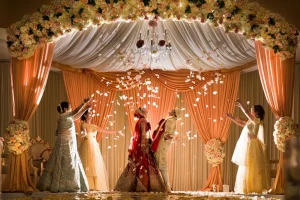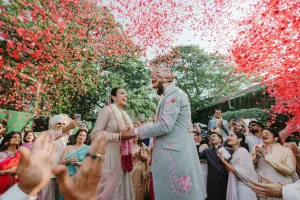Indian weddings are renowned for their grandeur, vibrant colors, and rich cultural traditions. Attending one is an experience like no other, but it also comes with the dilemma of what to wear. Whether you’re the bride, groom, or a guest, selecting the right attire is crucial to fitting in and respecting the occasion. In this guide, we’ll delve into the intricacies of dressing for an Indian wedding, offering tips and insights to ensure you look your best while honoring tradition. And for those in Dubai, BRIDAL SHOWROOM DUBAI offers an exquisite range of outfits to make your ensemble perfect.
Understanding Indian Wedding Attire
Traditional Indian Attire:
Indian weddings are a celebration of tradition, and attire plays a significant role in reflecting this. For women, traditional options include sarees, lehengas, and salwar kameez, while men often opt for sherwanis, kurta pajamas, or suits with ethnic accents. These outfits come in a myriad of colors, fabrics, and embellishments, allowing for personal expression while adhering to cultural norms.
Color Symbolism:
Colors hold special significance in Indian culture, with each shade representing different emotions, beliefs, and rituals. For instance, red symbolizes love and passion, making it a popular choice for brides, while gold represents prosperity and auspiciousness. Understanding these symbolic meanings can help in selecting appropriate attire for different wedding events.
Selecting the Perfect Outfit
Consider the Venue and Theme:
Indian weddings often comprise multiple ceremonies and events, each with its own ambiance and dress code. Consider whether the event is taking place during the day or evening, as this can influence your outfit choice. Daytime events may call for lighter colors, breathable fabrics, and more casual attire, while evening events tend to be more formal and glamorous, allowing for richer colors and luxurious fabrics.
Indoor vs. Outdoor Venues:
The venue of the wedding also plays a significant role in determining the appropriate attire. Indoor venues offer climate-controlled environments, allowing for more flexibility in outfit choices. Outdoor venues, on the other hand, may require consideration of factors such as weather conditions, terrain, and comfort. Lightweight fabrics and practical footwear are advisable for outdoor ceremonies, while indoor venues offer more freedom to experiment with elaborate outfits.
Dress Code and Cultural Sensitivities:
Indian weddings often blend traditional customs with modern influences, giving guests the opportunity to showcase their personal style while respecting cultural traditions. Understanding the dress code specified by the hosts is essential to ensure that your outfit aligns with the theme of the event. While traditional attire such as sarees, lehengas, and sherwanis are typically favored, contemporary interpretations and fusion ensembles are also acceptable, provided they maintain cultural sensitivity.
Modesty and Respect:
Indian culture places a strong emphasis on modesty and decorum, particularly during religious ceremonies and rituals. When selecting your outfit, ensure that it adheres to cultural norms and respects the sanctity of the occasion. Avoid attire that is overly revealing or inappropriate for the setting, opting instead for elegant and tasteful ensembles that reflect reverence and respect.
Personal Style and Expression:
Expressing Individuality:

While adhering to cultural traditions is important, Indian weddings also provide an opportunity for guests to express their individuality and personal style. Whether you prefer vibrant colors, bold patterns, or subtle elegance, choose an outfit that reflects your personality and makes you feel confident and comfortable. Experiment with different styles, silhouettes, and accessories to create a unique and memorable look that sets you apart.
Accessorizing Creatively:
Accessories play a crucial role in elevating your outfit and adding a touch of glamour to your overall look. From statement jewelry and embellished footwear to ornate clutches and traditional headpieces, the right accessories can transform a simple outfit into a show-stopping ensemble. Experiment with different combinations and textures to find the perfect balance between tradition and modernity.
BRIDAL SHOWROOM DUBAI:
Expert Guidance and Selection:
For guests attending an Indian wedding in Dubai, BRIDAL SHOWROOM DUBAI offers an extensive selection of traditional and contemporary Indian attire, ensuring that every guest finds the perfect outfit for the occasion. With expert guidance from experienced stylists, guests can explore a wide range of options tailored to their preferences, style, and budget.
Tailored Solutions:
BRIDAL SHOWROOM DUBAI provides tailored solutions to meet the diverse needs of guests attending Indian weddings. Whether you’re looking for a traditional saree, a modern lehenga, or a classic sherwani, their team of professionals can help you find the perfect outfit that reflects your style and personality while adhering to cultural norms and traditions.
For the Bride and Groom
Bridal Ensemble:
The bride’s attire is often the focal point of an Indian wedding. Traditional Indian bridal wear typically consists of a lehenga choli or saree adorned with intricate embroidery, embellishments, and luxurious fabrics like silk, velvet, or chiffon. These outfits are often custom-designed or selected with meticulous care to reflect the bride’s personal style and cultural heritage.
Jewelry:
Alongside the bridal attire, jewelry plays a crucial role in completing the bride’s look. Traditional bridal jewelry includes elaborate necklaces, earrings, bangles, and rings, often crafted from gold, diamonds, or precious gemstones. Each piece holds symbolic significance and may be passed down through generations as heirlooms.
Hair and Makeup:
Hairstyling and makeup are integral aspects of the bride’s overall appearance. Brides often opt for elaborate hairstyles adorned with fresh flowers, jewels, or ornate hair accessories like tiaras or maang tikka. Makeup is typically radiant and long-lasting, enhancing the bride’s natural beauty while complementing her outfit and jewelry.
Veil or Dupatta:
Many brides choose to wear a veil or dupatta (scarf) as part of their bridal ensemble. This sheer fabric is draped elegantly over the head or shoulders and adds a touch of grace and modesty to the outfit. The dupatta may be embellished to match the bridal attire or contrast with it for visual interest.
Footwear:
Comfortable yet stylish footwear is essential for the bride, especially considering the long hours spent on her feet during various wedding ceremonies and rituals. Bridal footwear often features intricate embellishments, beading, or embroidery to coordinate with the rest of the ensemble.
Groom’s Attire:
While the bride typically receives much of the attention, grooms also have a wide range of attire options for their wedding day. Traditional Indian groomswear includes the sherwani, a long coat-like garment often adorned with intricate embroidery, paired with either churidar pants or dhoti trousers. Alternatively, grooms may opt for a kurta pajama ensemble or a contemporary suit with ethnic accents.
Accessories:
Like brides, grooms also accessorize their attire to complete the look. This may include a turban or safa adorned with embellishments or jewels, adding regal elegance to the ensemble. Other accessories such as brooches, necklaces, or cufflinks may also be incorporated to add a personal touch.
Footwear:
Grooms typically wear traditional footwear such as juttis or mojaris, intricately crafted leather shoes adorned with embroidery or embellishments. These shoes complement the groom’s attire while providing comfort and style throughout the wedding festivities.
Hair and Grooming:
Grooming plays a vital role in achieving a polished and dapper look for the wedding day. Grooms may opt for a well-groomed beard or a clean-shaven appearance, depending on personal preference and cultural customs. Hairstyling should be neat and complement the overall look, whether styled with gel or left natural.
Personalization:
Many grooms choose to personalize their wedding attire to reflect their individual style and personality. This may involve selecting specific colors, fabrics, or accessories that hold personal significance or cultural relevance. BRIDAL SHOWROOM DUBAI offers tailored solutions to ensure that every groom looks and feels his best on his special day.
Hair and Makeup:
Professional Services:
Investing in professional hair and makeup services can elevate your look and ensure that you appear polished and camera-ready for the wedding festivities. Many Indian weddings involve elaborate ceremonies and rituals, and having a skilled makeup artist and hairstylist on hand can help you achieve a flawless appearance that lasts throughout the day.
Traditional vs. Contemporary Styles:

When selecting your hairstyle and makeup, consider whether you want to embrace traditional Indian looks or opt for more contemporary styles. Traditional hairstyles such as braids adorned with flowers or intricate bun styles are popular choices for Indian weddings, while makeup trends may include bold eyes, dewy skin, and statement lips.
Arrive Early and Dress Appropriately:
Punctuality:
Indian weddings often follow a strict schedule, with ceremonies starting at predetermined times. Arriving early ensures that you have ample time to navigate the venue, greet the hosts, and settle into your designated seat before the festivities begin. It also demonstrates respect for the hosts and the significance of the occasion.
Dress Code Adherence:
Dressing appropriately for each event is essential to show respect for the hosts and adhere to cultural customs. Ensure that your attire aligns with the dress code specified on the wedding invitation and is suitable for the time of day and venue. If in doubt, opt for conservative and elegant outfits that reflect the solemnity and joy of the occasion.
Respect Cultural Customs and Traditions:
Observance of Rituals:
Indian weddings are steeped in rich cultural traditions and rituals, each carrying its own significance and symbolism. Respect these customs by observing them attentively and participating respectfully when appropriate. Whether it’s the exchange of garlands during the jaimala ceremony or the application of sindoor during the sindoor daan ritual, approach each tradition with reverence and understanding.
Interacting with Elders and Relatives:
Indian weddings often bring together family members and relatives from near and far, providing an opportunity to reconnect and strengthen bonds. Show respect to elders and relatives by greeting them warmly, addressing them with appropriate titles, and participating in family rituals and traditions with enthusiasm and sincerity.
BRIDAL SHOWROOM DUBAI:
Comprehensive Services:
BRIDAL SHOWROOM DUBAI offers more than just attire; they provide comprehensive services to ensure that guests attending Indian weddings in Dubai are well-prepared and impeccably presented. From professional hair and makeup services to personalized styling advice, their team of experts can assist guests in achieving a polished and sophisticated look for the occasion.
Cultural Sensitivity:
BRIDAL SHOWROOM DUBAI understands the importance of cultural sensitivity when it comes to selecting attire and accessories for Indian weddings. Their curated collection of outfits reflects the diverse traditions and customs of Indian culture while offering modern interpretations and contemporary designs that appeal to a global audience.
Attending an Indian wedding is a truly magical experience, and dressing the part adds to the joy and celebration. Whether you’re the bride, groom, or a guest, selecting the perfect attire requires careful consideration of tradition, culture, and personal style. BRIDAL SHOWROOM DUBAI offers an exquisite selection of outfits and accessories to make your Indian wedding ensemble truly unforgettable. By following the tips and guidelines outlined in this guide, you’ll be sure to turn heads and make a lasting impression at the next Indian wedding you attend.



